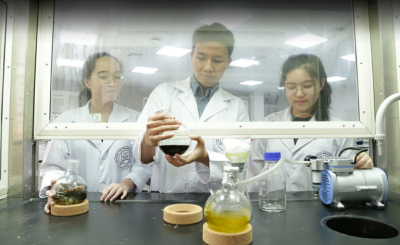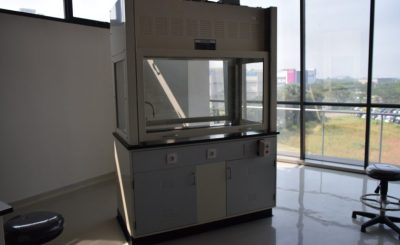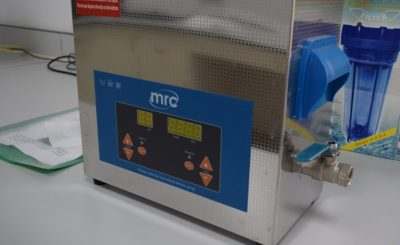Chemistry Lab
This lab is designed to support and illustrate chemical concepts as a part of the learning objective, to introduce chemical laboratory techniques, to improve laboratory skill, observation, and data analysis and to encourage analytical thinking.
Equipment Usability
- Analytical Balance
Analytical balances are precision measuring instruments used in quantitative chemical analysis, to determine the mass of solid objects, liquids, powders, and granular substances. Their readability has a range between 0.1mg – 0.01mg. Analytical balances have a draft shield or weighing chamber to prevent very small samples from being affected by air currents.
- Precision Balance
Dapat menimbang yang lebih berat daripada timbangan analitik dan lebih mudah dibaca.
- Refractometer
digunakan untuk mengukur kadar/ konsentrasi bahan terlarut.
- Centrifuge
A centrifuge is a laboratory device that is used for the separation of liquid, based on density. Separation is achieved by spinning a vessel containing material at high speed. The centrifugal force pushes heavier materials to the outside of the vessel.
- Shaking Waterbath
A shaking water bath is a laboratory device that is used to steadily shake and mix samples while maintaining a constant temperature.
- Drying Oven
A drying oven is designed to remove moisture from the oven chamber so as to dry the samples as quickly as possible. The drying oven process introduces fresh dry air to the chamber and expels the warm moist air simultaneously allowing it to rapidly dry the samples. A drying oven provides high-performance drying and heating
- Hot Plate Stirrer
Hot plate stirrer / hot plate magnetic stirrer keeps liquids circulating as they are heated for a faster, more even reaction. They are very useful when you need to mix components, either solids or liquids, and get a homogeneous liquid mixture while heating.
- Vortex Mixer
A vortex mixer is a simple device used commonly in laboratories to mix small vials of liquid. It consists of an electric motor with the drive shaft oriented vertically and attached to a cupped rubber piece mounted slightly off-center. As the motor runs the rubber piece oscillates rapidly in a circular motion. When a test tube or other appropriate container is pressed into the rubber cup (or touched to its edge) the motion is transmitted to the liquid inside and a vortex is created.
- pH meter
A pH meter is an instrument used to measure the acidity or alkalinity of a solution – also known as pH. Fundamentally, a pH meter consists of a voltmeter attached to a pH-responsive electrode and a reference (unvarying) electrode. The pH-responsive electrode is usually glass, and the reference is usually a mercury–mercurous chloride (calomel) electrode. When the two electrodes are immersed in a solution, they act as a battery. The glass electrode develops an electric potential (charge) that is directly related to the hydrogen-ion activity in the solution, and the voltmeter measures the potential difference between the glass and reference electrodes.
- Conductivity Meter
A conductivity meter is used to measure the amount of electrical current in a solution. This electric device is used for determining the purity of water. A conductivity meter usually consists of a probe that is used for measurements. This probe is placed in the liquid to be measured and the other meter applies the voltage between the two electrodes inside the probe. The meter reads the drop in the voltage caused by the electrical resistance from the solution.
- Blender
A laboratory blender is used to mix, purée, or emulsify food and other substances.
Spektrofotometer UV-Vis
UV-Vis Spectroscopy (or Spectrophotometry) is a quantitative technique used to measure how much a chemical substance absorbs light. This is done by measuring the intensity of light that passes through a sample with respect to the intensity of light through a reference sample or blank. This technique can be used for multiple sample types including liquids, solids, thin films, and glass. UV VIS spectroscopy is a powerful analytical chemistry technique for determining the concentration of analytes in a sample and tracking chemical reactions.
- Water Purifier
Water purifiers can produce Purified Water (Type II) for general laboratory use and Ultrapure Water (Type I) for highly sensitive applications from tap water.
- Ultrasonic Bath
An ultrasonic bath uses sound waves to agitate particles in solution. Such disruptions can be used to mix solutions, speed the dissolution of a solid into a liquid (like sugar into water), and remove dissolved gas from liquids.
- Vacuum Pump
Laboratory vacuum pumps are used to provide suction to drive the aspiration or filtration of liquid or suspended samples and to induce or control solvent evaporation by reducing vapor pressure, as in ovens, rotary evaporators, gel dryers, and concentrators
Courses Using Lab Materials
- Final Project
- Basic Chemistry
- General Chemistry I & II
- Food Biochemistry
- Food Chemistry
- Organic Chemistry
- Analytical Chemistry















